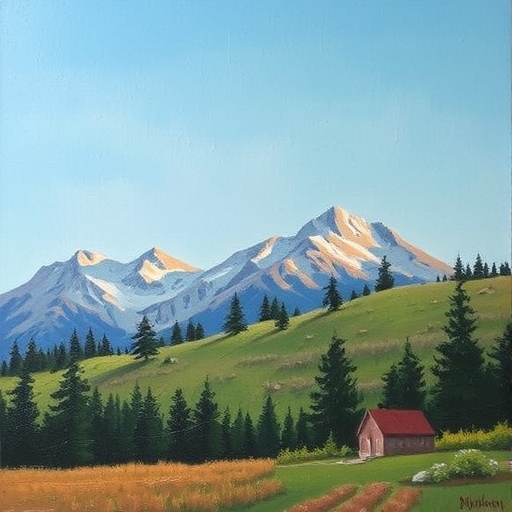The Elusive Dry Time- Understanding Oil Paint Drying
Oil painting, a venerable art form spanning centuries, captivates with its luminous depth and rich textures. However, mastering the medium requires a deep understanding of its inherent properties, particularly its notoriously slow drying time. This seemingly simple aspect can significantly impact an artist’s workflow, technique, and the final longevity of their work.
This article delves into the complexities of oil paint drying, exploring the factors that influence it and providing guidance for navigating this crucial aspect of the painting process.
The Science Behind the Slow Dry: Oxidation and Polymerization
Unlike acrylics or watercolors that dry primarily through evaporation, oil paints dry through a process of oxidation and polymerization. This is a chemical reaction, far more complex and influenced by external factors than simple water evaporation.
Oxidation: This is the initial stage where the oil in the paint (typically linseed oil, poppy seed oil, or safflower oil) reacts with oxygen in the air. This reaction initiates the formation of long, complex chains of molecules. The oil gradually hardens as oxygen atoms integrate into its structure.
Polymerization: This is the second phase where these oxidized oil molecules link together to form a three-dimensional network, creating a solid film. This process is gradual and continues long after the paint appears dry to the touch.
The speed at which these processes occur is affected by numerous variables, making it impossible to assign a single definitive drying time for oil paint.
Factors Influencing Oil Paint Drying Time
Several factors can dramatically influence how long it takes for your oil paint to dry:
1. Type of Oil:
Different drying oils have vastly different drying times.
Linseed Oil: This is the most commonly used oil, known for its fast drying properties (relatively speaking!). However, it can yellow over time.
Poppy Seed Oil: This oil dries slower than linseed oil and results in a less yellowed final product, making it popular for light colors.
Safflower Oil: This oil dries slower than linseed oil but even slower than poppy seed oil, offering a very slow drying time and minimal yellowing.
Walnut Oil: This oil dries moderately fast and offers a good balance between drying time and color retention.
2. Pigment:
The pigment used significantly impacts drying time. Some pigments act as catalysts, speeding up the oxidation process, while others can slow it down. Titanium white, for example, is known to accelerate drying, whereas certain earth pigments can slow it down.
3. Paint Consistency:
Thicker paint layers take considerably longer to dry than thin layers. This is because oxygen needs to penetrate the paint layer to reach the oil molecules within. Thick impasto layers can take weeks, months, or even years to dry completely.
4. Temperature and Humidity:
Environmental conditions play a crucial role.
Temperature: Warmer temperatures generally accelerate drying. A well-ventilated room with a consistent temperature is ideal.
Humidity: High humidity slows down drying significantly, as the moisture in the air competes with the oxygen needed for oxidation.
5. Mediums and Additives:
The use of mediums and additives can drastically alter drying times. Some mediums, like stand oil or alkyd mediums, are designed to speed up drying, while others, like linseed oil, slow it down. Always refer to the manufacturer’s instructions for the specific medium you are using.
6. Paint Quality and Age:
The quality of the paint itself impacts drying. Higher-quality paints often contain higher concentrations of oil, which can affect the drying time. Also, older paints, especially those that have been stored improperly, may dry slower.
Estimating Drying Time: A Practical Guide
While precise drying times are impossible to predict, we can offer some general guidelines:
Thin Layers: A thin layer of paint might dry to the touch in a few hours to a day. However, it will continue to cure for weeks or even months.
Medium Layers: These might take a few days to dry to the touch, with full curing taking several weeks.
Thick Layers (Impasto): These can take weeks, months, or even years to dry completely, depending on the factors mentioned above.
It’s crucial to remember that “dry to the touch” doesn’t mean the paint is fully cured. Complete curing involves the full polymerization of the oil, a process essential for the longevity and stability of the painting.
Strategies for Managing Drying Time
Artists employ various strategies to manage the long drying times associated with oil paints:
Working in Stages: Focus on completing small sections at a time, allowing each to dry before working on adjacent areas.
Thinning Paints: Use a medium to thin the paint, promoting faster drying.
Proper Ventilation: Ensure good air circulation in your studio to maximize oxygen access.
Temperature Control: Maintain a consistently warm temperature in your studio, if possible.
Patience: Understand that oil painting requires patience. Avoid rushing the process and allow ample time for each layer to dry properly.
Avoiding Problems Related to Slow Drying
Several issues can arise from insufficient drying time:
Cracking: If layers are applied before the previous layers are fully dry, the top layer may crack as it contracts.
Blending Difficulties: Wet-on-wet blending can be challenging with slow-drying paints, requiring skilled manipulation and timing.
Dust and Debris: Uncured paint is susceptible to dust and debris settling on the surface.
Color Changes: Incomplete curing can lead to shifts in color and tone over time.
FAQ: Oil Paint Drying
Q: How can I speed up the drying time of my oil paint?
A: Use a fast-drying oil like linseed oil, thinner paint layers, add a suitable drying medium (alkyd medium), maintain a warm and well-ventilated studio, and ensure your paint is high quality.
Q: How long does it take for oil paint to be completely cured?
A: Complete curing, meaning the full polymerization of the oil, can take months or even years, depending on several factors.
Q: My oil painting is still tacky after weeks. What should I do?
A: This suggests the paint hasn’t fully cured. Ensure proper ventilation and temperature. Avoid touching the painting. If the tackiness persists, consult a professional art conservator.
Q: Can I varnish an oil painting before it’s fully dry?
A: No. Varnishing too early can trap solvents and moisture, leading to cracking and other problems. Wait until the painting is completely dry and cured before varnishing.
Comparison of Oil Paint Drying Oils
| Oil Type | Drying Time | Yellowing Tendency | Color Impact |
|---|---|---|---|
| Linseed Oil | Relatively Fast | Moderate | Slight warmth |
| Poppy Seed Oil | Slow | Minimal | Bright, clear colors |
| Safflower Oil | Very Slow | Minimal | Very bright colors |
| Walnut Oil | Moderate | Low | Warm, slightly muted |
Ultimately, understanding oil paint’s drying time is essential for producing successful and lasting artwork. By understanding the scientific principles, the influential factors, and by employing appropriate techniques, artists can navigate the complexities of oil painting and create stunning masterpieces that stand the test of time. Patience, observation, and a respect for the chemical process are key ingredients in mastering this challenging yet rewarding medium.

